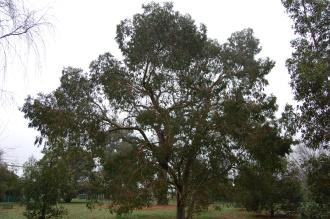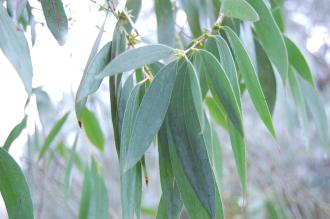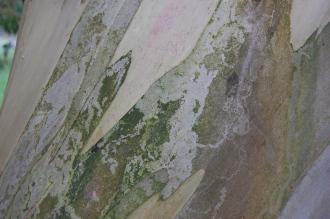
Eucalyptus stellulata (06/01/2013, Kew Gardens, London)
Position: Full sun to light shade
Flowering period: Summer
Soil: Moist, well drained
Eventual Height: 15m
Eventual Spread: 10m
Hardiness: 7b – 10b
Family: Myrtaceae
Eucalyptus stellulata is an evergreen tree with an open habit. As with most Eucalyptus trees it produces both juvenile and mature forms of its leaves. Its dull grey/ green juvenile leaves are orbiculate with entire margins and stalkless. Its glossy green mature leaves are lanceolate with entire margins, up to 9cm long and 2.5cm broad. Its bark is dark and rough at the base, smooth and peeing revealing yellowish and olive new bark further up. Its white/ cream flowers an appear in clusters of up to 15 and usually appear in the leaf axils. Its fruit are cup shaped to globular.

Eucalyptus stellulata Leaf (06/01/2013, Kew Gardens, London)
Eucalyptus stellulata, commonly known as Black Sallee, Muzzlewood or Black Sally, is native to south east Australia. In its native habitat it grows in open grassy Eucalyptus woodland.
The etymological root of the binomial name Eucalyptus is derived from the Greek eu meaning ‘good‘ and kalyptos meaning ’covered’ referring to the calyx which forms a lid over the flowers when in bud. Stellulata is derived from the Latin stella ‘star’, in reference to the shape of its flower buds.
The landscape architect may find Eucalyptus stellulata useful as an evergreen medium sized tree. This tree prefers a sheltered location
Ecologically, Eucalyptus stellulata is attractive to pollinating insects.

Eucalyptus stellulata Bark (06/01/2013, Kew Gardens, London)
Eucalyptus stellulata prefers moist, fertile, well-drained soils. It tolerates most pH of soil. It will tolerate wet soils.
Eucalyptus stellulata requires little maintenance. This tree may be coppiced on a 5 to 7 cycle.

